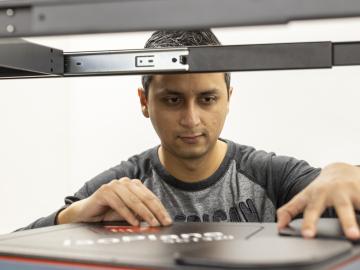
Filter News
Area of Research
- (-) Electricity and Smart Grid (1)
- (-) Neutron Science (46)
- (-) Nuclear Science and Technology (23)
- Advanced Manufacturing (7)
- Biological Systems (1)
- Biology and Environment (109)
- Biology and Soft Matter (1)
- Computational Biology (2)
- Computational Engineering (2)
- Computer Science (3)
- Energy Science (92)
- Functional Materials for Energy (1)
- Fusion and Fission (26)
- Fusion Energy (15)
- Isotope Development and Production (1)
- Isotopes (11)
- Materials (104)
- Materials Characterization (1)
- Materials for Computing (15)
- Materials Under Extremes (1)
- Mathematics (1)
- National Security (29)
- Quantum information Science (2)
- Supercomputing (65)
- Transportation Systems (1)
News Topics
- (-) Biomedical (16)
- (-) Cybersecurity (2)
- (-) Environment (9)
- (-) Fusion (9)
- (-) Materials Science (27)
- (-) Molten Salt (4)
- (-) Space Exploration (8)
- 3-D Printing/Advanced Manufacturing (10)
- Advanced Reactors (11)
- Artificial Intelligence (7)
- Big Data (2)
- Bioenergy (8)
- Biology (7)
- Biotechnology (1)
- Buildings (1)
- Chemical Sciences (3)
- Clean Water (2)
- Composites (1)
- Computer Science (15)
- Coronavirus (11)
- Energy Storage (7)
- Fossil Energy (1)
- Frontier (2)
- Grid (3)
- High-Performance Computing (3)
- Hydropower (1)
- Isotopes (5)
- Machine Learning (4)
- Materials (15)
- Mathematics (1)
- Microelectronics (1)
- Microscopy (3)
- Nanotechnology (10)
- National Security (2)
- Neutron Science (122)
- Nuclear Energy (38)
- Physics (10)
- Polymers (1)
- Quantum Computing (1)
- Quantum Science (7)
- Security (2)
- Simulation (1)
- Summit (6)
- Transportation (5)
Media Contacts

Research by an international team led by Duke University and the Department of Energy’s Oak Ridge National Laboratory scientists could speed the way to safer rechargeable batteries for consumer electronics such as laptops and cellphones.

In the 1960s, Oak Ridge National Laboratory's four-year Molten Salt Reactor Experiment tested the viability of liquid fuel reactors for commercial power generation. Results from that historic experiment recently became the basis for the first-ever molten salt reactor benchmark.

In the race to identify solutions to the COVID-19 pandemic, researchers at the Department of Energy’s Oak Ridge National Laboratory are joining the fight by applying expertise in computational science, advanced manufacturing, data science and neutron science.

As a teenager, Kat Royston had a lot of questions. Then an advanced-placement class in physics convinced her all the answers were out there.

A versatile class of flexible, protein-like polymers could significantly advance future drug delivery methods. But first, scientists have to develop a reliable process for tailoring these polymers into shapes that can effectively transport medicines throughout the human body.

The techniques Theodore Biewer and his colleagues are using to measure whether plasma has the right conditions to create fusion have been around awhile.

Biological membranes, such as the “walls” of most types of living cells, primarily consist of a double layer of lipids, or “lipid bilayer,” that forms the structure, and a variety of embedded and attached proteins with highly specialized functions, including proteins that rapidly and selectively transport ions and molecules in and out of the cell.

An international team of researchers has discovered the hydrogen atoms in a metal hydride material are much more tightly spaced than had been predicted for decades — a feature that could possibly facilitate superconductivity at or near room temperature and pressure.

Illustration of the optimized zeolite catalyst, or NbAlS-1, which enables a highly efficient chemical reaction to create butene, a renewable source of energy, without expending high amounts of energy for the conversion. Credit: Jill Hemman, Oak Ridge National Laboratory/U.S. Dept. of Energy

As scientists study approaches to best sustain a fusion reactor, a team led by Oak Ridge National Laboratory investigated injecting shattered argon pellets into a super-hot plasma, when needed, to protect the reactor’s interior wall from high-energy runaway electrons.


